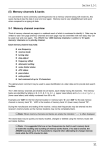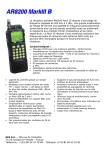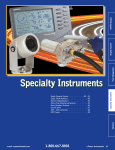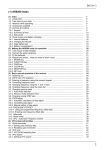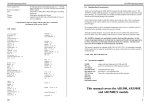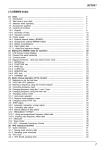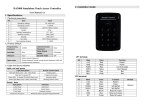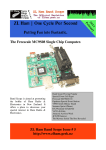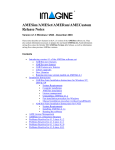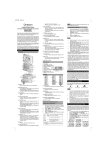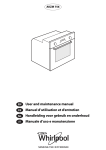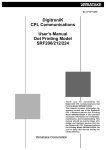Download 13-3 Short cut text entry, keypad with прст keys
Transcript
Section 13-3 13-3 Short cut text entry, keypad with ïðñò keys Text may also be entered using a combination of the keypad and ï ð ñ ò keys. While in a text input menu, for flashing “FUNC” legend then refer to the following table. Look for the required character in the table then PUSH the key shown to the horizontal-left followed by the ï ð ñ ò key shown above the required character (do not push both keys together). The first key push will produce a character on the screen which will be replaced with the required character when the second key is pushed, the cursor with then move one place to the right. &Note: The CASE SHIFT Example: To select the letter “N” key is used to access lower case letters. until the flashing “FUNC” is displayed. , the number “4” will be displayed, ï, the desired “N” character will be displayed and the cursor will move one position to the right. The flashing “FUNC” legend will continue to flash, if it is not required further Example: To select the letter “e” for it to be removed from the LCD. until the flashing “FUNC” is displayed. , the number “5” will be displayed, case letter is required (CASE SHIFT) to instruct the CPU that a lower ñ, the desired “e” character will be displayed and the cursor will move one position to the right. The flashing “FUNC” legend will continue to flash, if it is not required further for it to be removed from the LCD. 105 Section 14, 14-1, 14-2 (14) Configuration menu The configuration (CONFIG) menu is used to set fundamental operating parameters and other variables which do not appear in any other menu heading. BEEP Confirmation & error tone LAMP LCD & keypad illumination CONTRAST LCD contrast adjustment POWER-SAVE Delay & cycle power save AUTO PWR-OFF Auto inactivity power off REMOTE BPS RS232 baud rate RMT-ID Computer control address FREQ DISP Frequency readout on/off WRITE PROT Global write protect OPENING MESSAGE Change the power-up message 14-1 CONFIG BEEP The AR8200 emits confirmation ‘beeps’ while the keypad and side keys are used. A ‘HIGH’ pitched beep indicates correct operation while a ‘LOW’ pitched beep indicates that an error or unexpected entry has taken place. The volume of the beep is independent of the main volume control and can be separately defined. It is recommended that the beep facility be enabled, especially in the early days while gaining familiarity of the receiver. Beep is setup in the CONFIG menu. To access the config menu . The first item in the config menu is “BEEP”, the default is beep on with a volume level of 09. Use the main dial or ï ð keys to vary beep level between the range of OFF and 01 to 09 with 09 being the loudest. The key may be used as a short cut to 05. to accept the data and return to a standard display. Alternatively to abort entry or ò to move to the next item on the config menu (LAMP). 14-2 CONFIG LAMP The AR8200 is equipped with high intensity green LEDs to illuminate the LCD and front panel keypad when operating in areas of low level lighting. While the AR8200 is switched on and connected to an external power source such as the charger or d.c. lead, the lamp will be PERMANENTLY ON and cannot be switched off. The lamp will go out when the AR8200 is switched off (when the batteries are being charged etc). 106 Section 14-2, 14-3 The lamp may be configured in three ways: AUTO This setting is relevant when operating from internal batteries only. The lamp will automatically illuminate when the front panel and side panel keys are used. The lamp will remain illuminated for a further five second after the last key push and will then switch off. This is a good compromise setting for best visibility and battery life. CONT This setting is relevant when operating from internal batteries only. The lamp will CONTinuously illuminate the front panel and side panel keys. The lamp will only extinguish when the AR8200 is switched off. Of course continuous operation of the lamp will drain the internal batteries more quickly. OFF This setting is relevant when operating from internal batteries only. The lamp remains permanently extinguished, this is useful to maintain maximum battery life when used in areas of high light levels. The LAMP is setup in the CONFIG menu. To access the config menu ò to move the cursor to the “LAMP” selection point. . Use the main dial or ï ð keys to toggle the lamp between AUTO (default), CONT and OFF. The key may be used as a short cut to AUTO. to accept the data and return to a standard display. Alternatively ò to move to the next item on the config menu (CONTRAST). to abort entry or 14-3 CONFIG CONTRAST The AR8200 is equipped with variable LCD contrast which is adjustable in 32 steps to provide best visibility under different viewing angles, extremes of ambient light & temperature (and between sets due to variation). The default setting for contrast is 14. The display generally becomes too dark to read around 20 and too feint around 02, the key may be used as a short cut to 14. The CONTRAST is setup in the CONFIG menu. To access the config menu . ò twice to move the cursor to the “CONTRAST” selection point. Use the main dial or ï ð keys to vary the contrast level to achieve best visibility. to accept the data and return to a standard display. Alternatively to abort entry or ò to move to the next item on the config menu (POWER-SAVE). 107 Section 14-4 14-4 CONFIG Power save The POWER SAVE facility may be used to help the receiver to operate for longer periods of time between battery recharging. Power save is default OFF to prevent confusion while the AR8200 is in a “dormant” cycle as the receiver is effectively asleep and only wakes up for short periods to check for activity before going to sleep and becoming dormant again. &Note: While in a dormant state (waiting to cycle), the AR8200 behaves sluggishly. When power save is ON, the AR8200 will automatically switch ‘off and on’ but the display will appear permanently on as only the AR8200 “receive” circuitry is switched off and on (switching the receiver off for short periods of time is what saves power!), the microprocessor is left on permanently but in a reduced operating condition. When activated, two parameters may be varied to affect the way the receiver behaves, these are “DELAY” and “CYCLE”. DELAY: This parameter determines how long the AR8200 will remain active before going to sleep and becoming dormant and is timed from when the squelch last closed or keypad was last used. The available range is 01 to 30 seconds plus OFF (default off). When OFF, the power save does not operate. The key may be used as a short cut to OFF. CYCLE: When the receiver becomes dormant (delay has expired), the cycle parameter determines how long the AR8200 will remain dormant before its ‘wake up’ period begins. If a transmission takes place while dormant it will be missed, if however a transmission occurs during the wake up period, the AR8200 will continue to monitor until the transmission ends and DELAY / CYCLE takes place again. The available range is 0.5 to 9.5 seconds (default 3.0 key may be used as a short cut to 3.0 seconds. seconds). The The POWER SAVE parameters are setup in the CONFIG menu. To access the config menu . ò three times to move the cursor to the POWER SAVE “DELAY” selection point. Use the main dial or ï ð keys to vary the delay value, the key may be used as a short cut to OFF. ò to move the cursor to the POWER SAVE “CYCLE” selection point. 108 Section 14-4, 14-5, 14-6 Use the main dial or ï ð keys to vary the cycle value, the key may be used as a short cut to 3.0 seconds. to accept the data and return to a standard display. Alternatively ò to move to the next item on the config menu (AUTO PWR-OFF). to abort entry or 14-5 CONFIG Auto power off An auto power off facility is available to switch the AR8200 off automatically after a programmable period of squelch inactivity, this prevents the batteries from becoming flat when monitoring a completely inactive frequency. &Note: Be careful how you use auto power off as it might catch you out one day (if a short auto-power-off period has been set), auto power off setting is not cancelled with power off / on… if the AR8200 appears to switch itself off for no reason, check to make sure that you haven’t enabled auto power off (there is no associated LCD legend). AUTO POWER OFF is setup in the CONFIG menu. To access the config menu . ò five times to move the cursor to the “AUTO PWR-OFF” selection point. Use the main dial or ï ð keys to vary the time between 0.5 hours to 9.5 hours in 0.5 hr increments, the key may be used as a short cut to OFF. When the AR8200 squelch closes, the CPU will wait the length of time programmed in auto-power-off before automatically switching the AR8200 off. If the squelch opens again before auto switch off time has elapsed, the radio will not power down and the counter will be reset (i.e. an open squelch defeats auto power off). to accept the data and return to a standard display. Alternatively to abort entry or ò to move to the next item on the config menu (REMOTE BPS). 14-6 CONFIG REMOTE BPS The REMOTE BPS menu is used to configure the RS232 computer control settings as it is important that they exactly match those of an associated computer connection or another AR8200 (connected via the option socket and optional leads). The REMOTE BPS parameters are setup in the CONFIG menu. To access the config menu . ò six times to move the cursor to the “REMOTE BPS” selection point. Use the main dial or ï ð keys to vary the RS232 baud rate between 4800bps, 9600bps and 19200bps. The key may be used as a short cut to the default of 9600bps. 109 Section 14-6, 14-7, 14-8 ò to move the cursor to the “RMT-ID” selection point. Use the main dial or ï ð keys change the AR8200 RS232 IDENTIFICATION ADDRESS when multiple units are connected to the same port. It is possible to connect up to 99 units at once, each radio being assigned a different address. The value is adjustable between 00 and 99, the default is 00. The key may be used as a short cut 00. & Important note: It is extremely important to set the RMT-ID to 00 for normal operation of the RS232 connection and clone of data between radios. to accept the data and return to a standard display. Alternatively to abort entry or ò to move to the next item on the config menu (FREQ DISP). 14-7 CONFIG FREQ DISP It is possible to instruct the AR8200 NOT to display frequencies while in memory read, search and scan modes (should you wish for prying eyes not to see specifically what you are listening to). Liberal use of ‘text comments’ is recommended if you disable frequency display (turned it off) unless you choose to have really anonymous operation! & Note: Frequency display will be provided in VFO and VFO search and VFO scan even with the frequency display disabled. The FREQUENCY DISPLAY parameters are setup in the CONFIG menu. To access the config menu . ò eight times to move the cursor to the “FREQ DISP” selection point. Use the main dial or ï ð keys to toggle between key may be used as a short cut to ON ON and OFF. The (which is default). to accept the data and return to a standard display. Alternatively ò to abort entry or to move to the next item on the config menu (WRITE PROT). 14-8 CONFIG GLOBAL write protect It is possible to globally write protect the entire AR8200 data storage, this prevents memory entry, search bank programming, loading of data via the option socket, loading of data from the optional EM8200 etc. Use this feature carefully. Should you wish to leave your AR8200 safe in the knowledge that no-one will ‘mess it up’ (well maybe!)… toggle global write protect on. The global “WRITE PROTECT” status is setup in the CONFIG menu. To access the config menu . selection point. 110 ò nine times to move the cursor to the “WRITE PROT” Section 14-8, 14-9 Use the main dial or ï ð keys or key to toggle between ON and OFF (the default is off). to accept the data and return to a standard display. Alternatively ò to move to the next item on the config menu (OPENING MESSAGE). to abort entry or 14-9 CONFIG Opening message It is possible to display a welcome message while the AR8200 is powering up and collating its ‘boot-up’ information. There are three options for opening message: NORM Normal message is displayed at switch-on: WELCOME TO THE NEW WORLD OF AR8200. QUICK Blank screen at switch-on. USER Four lines of 12 characters may be entered for display at switch-on. Initially they are configured for you to enter OWNERS name and PHONE NUMBER but all lines may be over-written. The “OPENING MESSAGE” is setup in the CONFIG menu. To access the config menu . ò ten times to move the cursor to the “OPENING MESSAGE” selection point. Use the main dial or ï ð keys to toggle between NORM / QUICK / USER. The key may used as a short cut to NORM (which is the default). to accept the data and return to a standard display or to abort entry. Alternatively if you have selected USER and wish to change the text comment ò to access the text input menu for the opening menu. You may change all four lines of text in the usual manner. Please refer to section 12-1 of this manual for further information regarding text input. to accept the data and return to a standard display or to abort entry. When the AR8200 is switched off and back on again, the new opening message will be displayed. 111 Section 15, 15-1 (15) Band scope The AR8200 is equipped with a flexible band scope function which is capable of graphically displaying band activity. The maximum frequency span width is 10 MHz, you may zoom in on activity to a span width of 100 kHz. Centre frequency is displayed and a marker may be manipulated to ascertain the frequency of activity using the graphical display. One trace may be saved to memory for recall at a later time and may be overwritten at will. The trace may also be saved and loaded from the optional EM8200 external memory slot card. &Note: Priority operation is disabled when the band scope is in operation. Audio is muted. The optional RU8200 is inoperative when the band scope is in operation. It is suggested that the band scope facility is ‘experimented with’ on a constantly active band such as VHF Band-II broadcast. 15-1 Starting the band scope To start the band scope . The frequency span width will be set to 10 MHz with the last frequency displayed in 2VFO, search, scan or memory read mode being used as the centre frequency. AUDIO IS MUTED. The centre frequency is displayed in the top left of the LCD, one pixel will be missing from the centre of the graphical base line indicating centre frequency position. A progress cursor which comprises of a single pixel on the graphical base line travels from left to right updating the band scope display… this confirms that the band scope is IN OPERATION (especially useful when a trace is simply being updated or no signals have been located). The frequency span width is displayed in the upper right corner of the LCD, at default this is 10 MHz. The frequency marker legend “MKR” is displayed on the second line of the LCD, the marker is also represented graphically by an upturned triangle (initially placed above-centre of the graphical trace). When first activated, the centre and marker frequencies are the same (but may be altered). The graphical trace is built-up from left to right. If no transmissions are encountered the display will simply form a horizontal line around two pixels in height. When activity is located, vertical lines are produced on the LCD, the stronger the signal the higher the line. &Important: To monitor the transmission of the marker frequency key. The progress of the scope is halted when the has no effect on the band scope trace. 112 and hold the key is held. Squelch setting Section 15-2, 15-3, 15-4, 15-5 15-2 Exit from band scope To exit the band scope or or . 15-3 Setting frequency span width (waveform enlargement) The frequency span width may be adjusted between the limits of 10 MHz (default) to 100 kHz using the ñ ò keys. The span widths available are: 10 MHz 35s for full trace approx. 5 MHz 20s for full trace approx. 2 MHz 10s for full trace approx. 1 MHz 6s for full trace approx. 500 kHz 3s for full trace approx. 200 kHz 6s for full trace approx. 100 kHz. 3s for full trace approx. Resolution is 10 kHz with a 12 kHz IF filter selected (NFM or AM) so that one pixel represents 140 kHz at maximum signal strength Resolution is 2 kHz with a 3 kHz filter (USB, LSB, CW) When the frequency span width is altered, the trace restarts. to refresh the trace from the start. 15-4 Moving the marker To move the marker position use the ï ð keys, the channel step will be dependant upon the span width resolution. To monitor the marker frequency the scope is halted when the and hold the key. The progress of key is held. 15-5 Marker to strongest signal (peak search) To simplify operation, it is possible to ‘jump the marker’ to the strongest signal of the current graphical trace (peak search). and hold the key until the “«” legend is displayed indicating that the marker is set to the strongest graphical signal. and hold the key to monitor the selected frequency. The ï ð keys may be used to hop between the strongest few transmissions. to disable peak search, the “«” will be removed from the LCD. &Note: If no signal is found above the background level (or if there hasn’t been time allowed for a trace to form), peak search will not operate and an error beep will be emitted (if beep is enabled). This facility cannot be used with a span width of 100 kHz. 113 Section 15-6, 15-7, 15-8, 15-9 15-6 Entering a new centre frequency To enter a new centre frequency, simply tap the wanted frequency into the keypad. The legend “CENTRE FREQ” will be displayed on the top line of the LCD with entry taking place on the second line. To complete entry in MHz format . The marker will be automatically set to the centre frequency but the frequency span width will be unchanged. 15-7 Transfer of marker frequency to VFO There are two ways in which the marker frequency may be transferred to VFO for long term monitoring. Transfer to 2VFO retaining VFO data to move marker frequency to 2VFO, receive mode and step are those of the VFO. Transfer to single VFO with 10 kHz tuning step Hold the key then to transfer marker frequency to single VFO, receive will be that used in VFO mode but the tuning step will always be 10 kHz to allow sensible re-tuning in VFO mode for best reception of the transferred marker frequency 15-8 Peak hold The PEAK HOLD facility is used to build up an image of band activity over a period of time, the display is not totally cleared each time a trace is made, only strong signals are added. To toggle PEAK HOLD on/off , the “HLD” legend confirms when peak hold is active. The ï ð keys may be used to move the marker position and key may be held to monitor activity on the marker frequency. 15-9 Saving active trace to memory To save the current trace to internal memory (for later retrieval) . It is suggested that the peak hold facility be employed before saving a trace so that it provides more meaningful information. If the optional EM8200 is used, it possible to save four further traces to external memory. Refer to section 18-6-7 of this manual for further information regarding this feature. 114 Section 15-10 15-10 Loading stored band scope traces from memory Providing a trace has been previously stored to memory, it is possible to recall it to display using the key sequence . The legend “RCV” (in the place of “MKR”) indicates that a stored trace is currently being displayed. The AR8200 will no longer sweep the frequency range but the key may still be used to monitor the marker frequency. Key in a new centre frequency to return to a real time band scope. It is possible to move the marker across the graphical trace using the ï ð keys. Waveform enlargement is available by changing the frequency sweep width using the ñ ò keys. If the optional EM8200 is used, it possible to load any one of four further traces from external memory. Refer to section 18-6-7 of this manual for further information regarding this feature. 115 Section 16 (16) Sleep ¹ It is possible to instruct the AR8200 to automatically switch-off after a predetermined time, this is particularly useful if you know that you may be called away from the receiver or listen to it while in bed and don’t want the batteries to become completely flat. Use the key sequence to accesses the SLEEP menu. Use the main dial, ï ð keys or key to toggle sleep on/off. For convenience SLEEP is default ON when this menu is accessed so that you have simply to access and exit the menu for sleep to be activated. Either or to save the changes and exit the menu ò to move the cursor to the sleep TIME menu. Use the main dial to set sleep time in 1s increments or ï ð keys to increment in 10 seconds, the range is between 1 and 120 minutes, is a short cut to 60 minutes (default). The AR8200 will automatically switch off after the programmed time has elapsed. To accept the data and activate sleep the circular CLOCK legend . The display will return to standard format and ¹ will be displayed to remind you that automatic power off will take place. The next time that the AR8200 is powered on, the sleep facility will be automatically cancelled. 116 Section 17 (17) Option socket The option socket is mounted on the right hand side of the cabinet underneath the 12V d.c. input socket. The socket is protected from dust by a grey rubberised case stopper which is hinged toward the front of the cabinet. Gently lift the stopper from the rear edge to reveal the D-shaped metallic socket. Be careful to keep dust and dirt from this socket and to prevent liquid entering the AR8200 via this socket. Ensure that no conductive material is allowed to short circuit the socket which may damage the receiver. The option socket has three main uses: 1. Connection of the optional CR8200 tape recording lead 2. Connection of the optional CO8200 data clone lead 3. Connection of the optional CC8200 computer control lead with level shift (available with imperial (PC98) & metric (DOSV) screws) Other signals are available via the option socket including detector output, mute and AGC. Typical pin-out of the optional leads are as follows: RED +4.2V BLACK RXD BLUE GROUND BROWN MUTE ORANGE AGC SHIELD GROUND WHITE TXD YELLOW GROUND GREEN AUDIO OUT GREY DETECTOR OUT PURPLE GROUND Output levels are as follows: MUTE CMOS (0V or 5V) AUDIO OUT Constant level into greater than 10k OHMS DETECTOR OUT Available in NFM & SFM, impedance 10k OHMS AGC 3.5V to 0.5V, impedance 10k OHMS RS232C TXD + RXD (levels to drive a level shift converter) &Note: The voltage output level to drive external RS232 is deliberately below ‘H’ level. If connecting to an external I.C., you must be aware of latch status. PSU 4.2V at 20mA 117 Section 17-1, 17-2 17-1 RS232 operation Connect the optional CC8200 computer control lead to the option socket and connect to a computer. The command protocol is provided with the CC8200 on floppy disk as an Adobe Acrobat PDF file. The RS232 parameters may be defined using the CONFIG menu. Baud rates (transfer speed) may be set to 4800, 9600 or 19200bps. It is also possible to set an ‘address’ to facilitate connection of up to 99 AR8200 to a single port for custom operation, the addresses may be set between the limits of 01 to 99 with 00 representing single radio operation. When operating from external RS232, the legend ¤ will be displayed on the LCD. Please refer to section 14-6 of this manual for information on the CONFIG menu settings. 17-2 CLONE of data via the option socket It is possible to copy data (clone) between two AR8200 receives using the optional CO8200 clone lead, no computer is required. &Note: As clone of data takes a while, it is suggested that the receivers are connected to external power or at least that the NiCads are FULLY charged while cloning data. Do not prematurely terminate the clone of data in any way or data corruption may occur… do not switch either AR8200 off, disconnect the CO8200 or disconnect power. Data can be copied in either direction but the EM8200 is not supported, only INTERNAL data can be copied between radios. Connect each radio to the CO8200 lead and switch them on. The following table indicates the facilities available: 118 ALL DATA All data is transferred from one radio to the other (approx. 8 minutes 30 seconds) SEARCH BANK A specific search bank is copied to the same or different bank number of the second radio (approx. 3 seconds) ALL SEARCH All search banks are copied from one radio to the other keeping bank numbers the same (approx. 1 minute 30 seconds) MEM BANK A specific memory bank is copied to the same or different bank number of the second radio. Ensure that the memory banks have the same sizes allocated (dynamic memory bank resizing) or data may be lost (approx. 30 seconds) ALL MEM All memory banks are copied from one radio to the other keeping bank numbers the same. Memory banks are handled as a ‘pair’ (A/a, B,b etc). If memory banks are not the same size (dynamic memory bank resizing), some data will be lost. (approx. 5 minutes) Section 17-2-1 17-2-1 How to clone data Ensure that the RS232 baud rate is set to the same speed for both radios and that the address is set to 00 on both units (refer to section 14-6 of this manual for information on the CONFIG menu settings). a) Pick the radio which you wish to copy TO (target) First decide which unit will be used to receive (LOAD) the data. to access the “COPY RS232C” menu. The key acts as a toggle between “LOAD” and “SAVE” (the default is LOAD), alternatively use the main dial or ï ð keys to select LOAD. b) Decide WHAT you want to copy the ò key to move down the COPY RS232C menu, the cursor will be flashing to the left of the item “ALL-DATA”. If you want to load , alternatively use the main dial or ï ð ALL DATA keys to select the type of data you wish to load (copy) from the other radio. . The bottom two rows of the LCD will display the legends “LOADING !!” and a number. The number will start counting downward when the copy process starts (when the other radio has been instructed to SAVE), the more data you have selected, the higher the number… for ALL-DATA the number will typically be 448. c) Configure the radio used to SAVE to access the “COPY RS232C” menu. On the second radio, The key acts as a toggle between “LOAD” and “SAVE” (the default is LOAD), alternatively use the main dial or ï ð keys to select SAVE. the ò key to move down the COPY RS232C menu, the cursor will be flashing to the left of the item “ALL-DATA”. If you want to load ALL DATA , alternatively use the main dial or ï ð keys to select the type of data you wish to save (send) to the other radio. It is most important that the type of data selected is IDENTICAL on both radios. . The bottom two rows of the LCD will display the legends “SAVING !!” and a number which will start 119 Section 17-2-1 counting downward to indicate that the copy process (clone of data) has started. When the number reaches zero the copy process will have completed, both radios will revert to standard displays. &Note: If you make a mistake during programming, it is possible to the key to exit the menu. However, be careful and get it right in the first place… this is the best way of avoiding the possibility of data corruption. Write protect Individual memory channel protect and search bank protect status is ignored, however global protect will prevent data being cloned between radios. 120 Section 18, 18-1, 18-1-1 (18) Slot card socket The slot card is located in the bottom of the AR8200 cabinet and protected from dust etc by a door which is hinged toward the back edge of the cabinet. To access the socket place the AR8200 on its back and open the front edge of the protective door. Be careful to keep dust and dirt from this socket and to prevent liquid entering the AR8200 via this socket. Ensure that no conductive material is allowed to short circuit the socket which may damage the receiver. 18-1 Optional slot cards Any ‘one’ optional card may be fitted at any time. Do not use anything other than the ‘genuine’ AOR slot cards. The slot card has five main uses: 1. VI8200 Voice inverter (analogue) in 157 steps 2. CT8200 CTCSS squelch & search 3. TE8200 Tone eliminator in 256 steps 4. RU8200 Chip based recording and playback, 20 seconds approx. 5. EM8200 External extended memory, backup 4,000 memories, 160 search banks (can hold as much data as 4 x AR8200) Signal types depend upon the slot card fitted, these include: l 4.2V PSU l GROUND l CARD RECOGNITION l AUDIO IN l AUDIO OUT l CARD CONTROL IN l CARD CONTROL OUT 18-1-1 Fitting the slot card Always switch the AR8200 off when inserting slot card. To access the socket place the AR8200 on its back and open the front edge of the protective door. With the AR8200 keypad facing upward, hold the slot card so that its label also faces upward. An arrow printed on the slot card indicates the direction of entry into the AR8200, insert the connector end of the slot card into the AR8200 (the end you will be left holding has groves to help grip). Without using excessive force, use a thumb to push the slot card fully into the body of the AR8200 until it is slightly recessed into the bottom of the receiver. Close the hinged slot card compartment cover. &Note: The AR8200 will automatically recognise each optional slot card, there is no need to initialise the option (except for the EM8200, see later). When slot cards are fitted, the AR8200 menu system dynamically changes to reflect the slot card 121 Section 18-1-1, 18-1-2, 18-2 currently fitted. If however the AR8200 ‘thinks’ that a slot card option is fitted when it isn’t, access the slot card menu and disable the option. You may wish to leave certain items selected if they are not affecting current operation in order to minimise reprogramming when slot cards are inter-changed at a later time. 18-1-2 Removing the slot card Always switch the AR8200 off when removing a slot card. To access the socket place the AR8200 on its back and open the front edge of the protective door. An EJECT slider is mounted on the left hand side of the AR8200 cabinet. With the AR8200 keypad facing upward slide the EJECT control toward the side keys of the AR8200, the thumb is best for this purpose… hold the thumb of the other hand one or two centimetres (one inch) from the bottom of the slot card to prevent it shooting out of the AR8200 and falling on the floor. The stiffness of the cards varies and may be tighter when used for the first few times, the EJECT slider needs quite a push but don’t use excessive force or tools! 18-2 VI8200 optional voice inverter slot card The VI8200 enables the AR8200 to recover intelligible audio from certain types of analogue transmission which would otherwise sound scrambled. They operate by splitting up the audio spectrum and ‘flipping’ the upper and lower tones around a certain frequency point. The VI8200 enables 157 different ‘flip points’ to be selected in the frequency range of 2.4 kHz to 5.6 kHz. Insert the VI8200 slot card and switch the AR8200 on, select VFO mode. to access the slot card option menu. The AR8200 will have recognised that the VI8200 has been fitted so will present the voice inverter menu. the The legend “VOICE INVERT” confirms selection of the voice inverter menu. key to toggle the voice inverter on/off (default on). Use the main dial or ñ ò keys to make selection of tone in 157 steps from 0 to 156, the ï ð keys are used to increment selection by 10. To accept the data input (when audio is intelligible) , alternatively to abort entry . Refer to the relationship table between value and ‘flip’ frequency: Frequency (kHz) Inverter value 2.4 2.8 3.2 3.6 4.0 4.4 4.8 5.2 5.6 6.0 6.15 0 37 64 86 102 116 128 138 146 154 156 When the voice inverter has been activated and you exit from the voice inverter menu back to VFO, the legend “v 68” will be displayed in the bottom right corner of the LCD. The legend “v” indicates that the 122 Section 18-2, 18-3. 18-3-1 inverter is active while the legend “68” indicates the current ‘flip’ value in use. To speed up the toggling of voice inverter, to effectively toggle the voice inverter option on/off. This is achieved as the default is set to voice inverter ON (by accessing the voice inverter menu) so that every time the voice inverter menu is accessed, the voice inverter is automatically activated. 1. For example, assume that the voice inverter is to access the voice inverter menu, the voice inverter currently OFF. menu cursor will move to “ON”. 2. to revert to VFO mode with the voice inverter on. 3. to immediately toggle the voice inverter off. The sequence then repeats each time you . &Note: Using the voice inverter to monitor normal transmissions will cause them to distort and sounds rather like tuning across a busy short wave band using USB. 18-3 CT8200 optional CTCSS slot card The CT8200 enables the AR8200 to search for 50 CTCSS tones which may be in use on the current receive frequency and to save a specific CTCSS tone (from the 50 tones available) into each VFO, each search bank and every memory channel individually. CTCSS is used by many amateur band repeaters, public utilities and private mobile radio services where shared resources are used, CTCSS ensures that operators only hear traffic intended for them. Insert the CT8200 slot card and switch the AR8200 on, select VFO mode. to access the slot card option menu. The AR8200 will have recognised that the CT8200 has been fitted so will present the CTCSS menu. The legend “CTCSS” confirms selection of the CTCSS menu. the key or use the ñ ò keys to toggle the CTCSS facility between OFF / ON / SRCH (default is off). To abort entry and exit the menu . &Note: You won’t be able to audibly hear a CTCSS tone due to the low frequencies employed and audio characteristics of the AR8200 (and other receivers). 18-3-1 CTCSS tone squelch 123 Section 18-3-1, 18-3-2 While in the CTCSS menu, to activate the CTCSS facility (the LCD legend “ON” is displayed in reverse highlight). Use the main dial or ï ð keys to make selection of CTCSS tone from the 50 available, the value cannot be adjusted when the menu is set to “OFF”. The current CTCSS tone is displayed on the last-but-one line of the LCD, the legend “«” is displayed to the left of the CTCSS frequency when the current receive frequency is using the displayed CTCSS tone, this assists manual selection of the correct tone. To accept the data input abort entry , alternatively to . The selected CTCSS tone may be used in VFO (separate CTCSS tones may be held in each VFO) and independent CTCSS tones saved in each search bank and memory channel. While in VFO, the legend “CTC” is displayed in the lower left corner of the LCD to indicate that CTCSS is active. The audio will be completely muted until a transmission occurs which contains the specified CTCSS tone even when the squelch is set fully anti-clockwise (open), it is normal for the occasional ‘splutter’ to be produced as ‘CTCSS type fingerprints’ naturally occur in everyday transmissions and background noise. Scan & search banks: It is even possible to scan & search with the squelch open when CTCSS is active but scan/search rates will be reduced significantly. To achieve the best speeds, set the squelch until the “S” legend is extinguished in the usual manner. Refer to the CTCSS table of available tones: 94.8 100.0 103.5 107.2 110.9 114.8 118.8 123.0 127.3 131.8 136.5 141.3 146.2 151.4 156.7 162.2 167.9 173.8 179.9 186.2 192.8 203.5 210.7 218.1 225.7 233.6 241.8 250.3 67.0 71.9 74.7 77.0 79.7 82.5 85.4 88.5 91.5 97.4 69.4 159.8 165.5 171.3 177.3 183.5 189.9 196.6 199.5 206.5 229.1 254.1 To switch CTCSS off, access the CTCSS menu legend “OFF” then to highlight the . 18-3-2 CTCSS search If you are uncertain what CTCSS frequency is in use, but you think there may be one present, you may 124 Section 18-3-2, 18-4 use the CTCSS SEARCH facility to discover what frequency is employed. Place the AR8200 into VFO mode then to access the CTCSS menu. to highlight the “SRCH” legend then to accept the input and exit the menu. The LCD legend “CT-S” will be displayed in the bottom left corner of the LCD to indicate that CTCSS SEARCH is in operation. While in 2VFO mode, the standby frequency will be replaced with the legend “CTCSS 205.5 Hz” when a CTCSS tone of 205.5 Hz has been located, otherwise the appropriate CTCSS frequency will be displayed. Each memory channel, VFO and search bank can hold different CTCSS frequencies and different settings of CTCSS squelch and CTCSS search (i.e. you can have CTCSS search active in VFO but CTCSS squelch active in memory channels). If you are uncertain where CTCSS may occur and wish to experiment with CTCSS search, simply activate the CTCSS SEARCH facility while monitoring a broadcast frequency (such as Band-II) which has a rich audio range (playing music etc). &Note: As CTCSS search has to check all 50 possible frequencies, it may take up to 15 seconds for the CTCSS tone to be identified. 18-4 TE8200 optional tone eliminator slot card The TE8200 enables the AR8200 to ignore certain transmission tones which would otherwise stop the scan and search processes. Pilot tones are often transmitted by public utility services and railways making their transmissions troublesome and fatiguing to monitor without the use of the TE8200. There are 256 values for the tone eliminator ranging from 0 to 255 representing a frequency range of 0.4 kHz to 4.2 kHz. Insert the TE8200 slot card and switch the AR8200 on, select VFO mode. to access the slot card option menu. The AR8200 will have recognised that the TE8200 has been fitted so will present the tone eliminator menu. The legend “TONE ELMT” confirms selection of the tone eliminator menu. the key to toggle the tone eliminator on/off (default off). Use the main dial or ñ ò keys to make selection of tone in 256 steps from 0 to 255, the ï ð keys are used to increment selection of tone in increments of 10. When selecting the value, the legend “ «” will be displayed to 125 Section 18-4, 18-5, 18-5-1 the left of the numeric value to indicate that the displayed tone value is contained in the current receive frequency, this greatly eases location of the offending tone frequency to allow scan and search to continue. To accept the data input , alternatively to abort entry . When active, the LCD legend “T.EL” will be displayed in the bottom left corner of the LCD. Refer to the table to reconcile value with frequency: Frequency (kHz) 0.4 0.6 0 70 Tone value 60 110 1.0 1.4 160 170 1.8 2.2 2.6 3.0 3.4 190 200 210 220 230 237 240 220 230 235 240 245 248 3.8 4.2 245 250 248 Tone eliminator setting and value may be held separately in each VFO, search bank and memory channel. The squelch should be set to threshold in the usual manner. Operation continues as normal with the tone eliminator active, however if a transmission is encountered which contains a ‘pilot tone’ which matches the current setting of the tone eliminator, the squelch will close allowing the scan and search processes to continue… i.e. the AR8200 will NOT think that it has found an active receive frequency or blank carrier. &Note: The tone eliminator does not remove whistles from the loudspeaker, it purely allows scan & squelch to continue unhindered. 18-5 RU8200 optional record & playback slot card The RU8200 enables around 20 seconds of audio to be recorded to a chip within the RU8200 for playback at a later time. The chip may be recorded to time and time again overwriting the previous recordings. The recording may be played back over and over, very useful if you have grabbed an interesting recording! The RU8200 may be used in VFO, scan, search and memory read modes. Insert the RU8200 slot card and switch the AR8200 on, select VFO mode. to access the slot card option menu. The AR8200 will have recognised that the RU8200 has been fitted so will present the record / playback menu. The legend “RECORDER” confirms selection of the record & playback menu. or use the main dial or ï ð ñ ò keys to toggle between “REC” and “PLAY” representing record and playback. to accept the selection and return to the previous menu or to abort. Recording and playback can be carried out while the AR8200 is in VFO, scan or search mode. 126 the key Section 18-5-1, 18-5-2, 18-6 18-5-1 Recording While in the record & playback menu select “REC” and . The LCD will return to its previous display with the legend “REC” in the bottom left corner of the LCD to show that the RU8200 is active. If the squelch is currently open, recording will take place immediately, otherwise recording will take place next time the squelch opens. While recording is in progress, the second line from the bottom of the LCD (usually displaying the standby frequency in 2VFO mode) changes to a progress bar “REC =====>” indicating that recording is in progress. Once started, the recording process continues for about 20 seconds and the legend “End” is displayed when the recording process is complete. Once started recording continues even if the squelch closes but you may the key half way through a recording to stop it from recording 20 seconds of nothing! the key after recording has ended to clear the recording related text from the LCD. &Note: RU8200 recording is disabled when the band scope facility is operational. 18-5-2 Playback It is assumed that you have already made a recording. While in the record & playback menu select “PLAY” and . The LCD will return to its previous display with the legend “PLY” in the bottom left corner of the LCD to show that the RU8200 is active. Playback will start instantly. While playback is in progress, the second line from the bottom of the LCD (usually displaying the standby frequency in 2VFO mode) changes to a progress bar “PLY =====>” indicating that playback is in progress. Once started, the playback process continues for about 20 seconds and the legend “End” is displayed when the playback is complete. You may the key to cancel playback or clear the recording related text from the LCD. &Note: No liability in any form will be accepted in respect of recordings made using the RU8200 option. 18-6 EM8200 optional external extended memory slot card The EM8200 enables the whole 1,000 memory channels in 20 banks and 40 program search banks to be backed up to the EM8200. In fact the EM8200 can hold the entire contents of the AR8200 including environmental operating data and band scope FOUR times in EM8200 locations 0, 1, 2 & 3. It is not necessary to save ALL data, you can specifically choose what data is to be backed up and to which location. 127 Section 18-6, 18-6-1 &Note: You cannot scan or search the backup information, data must be loaded back into the AR8200 before these processes can be activated. &Important note: Never remove the EM8200 with the AR8200 switched on, especially while data is being saved / loaded to and from the AR8200 or data corruption may occur. Saving all data takes some time, it is recommended that external power be used while copying large volumes of data to / from the EM8200 (or at least be sure that the batteries are well charged). No liability in any form will be accepted in respect of data saved to / loaded from the EM8200 option. &Note regarding write protect: If the write protect has been globally set to ON (ALL PROTECT) in the configuration menu ( ), data load will be unsuccessful and no data will be loaded. Individual memory channel protect, memory bank protect and search bank protect will be ignored during data load from the EM8200. &Note regarding possible NOISE: A small increase in ‘noise’ may be noticed while the EM8200 option is fitted inside the AR8200, this will disappear when the EM8200 is removed from the receiver. If signals are very weak or noise is a problem, temporarily remove the EM8200 option. The following table indicates the data types which may be saved to / loaded from the EM8200: 1 ALL-DATA All memories, search banks, band scope and environment data 2 ALL-MEM All memory channels 3 MEM-BANK One specified memory bank 4 ALL-SRCH All search banks 5 SRCH-BANK One specified search bank 6 B-SCOPE Band scope data 18-6-1 Initialising (formatting) the EM8200 before use The EM8200 has been tested during manufacture but is not fully formatted. Before you use the EM8200 for saving real data, you must format the memory, this only needs to be carried out once in the life of the EM8200 (similar to formatting a computer disk drive). To format the memory, simply execute a SAVE ALL to each of the four memory locations of the EM8200 (0, 1, 2 & 3). If you do not format the memory, you will still be able to carry out SAVE ALL (item 1 in the table) but the specific data saves (items 2, 3, 4, 5 & 6 will not operate). If you do not format the memory and later attempt to use a specific memory save or load, an error beep will sound (if beep is enabled). To access the COPY EXT-MEM menu (which is used for the EM8200 data save / load and has been selected dynamically in place of the COPY RS232C menu as the AR8200 recognises that the EM8200 is fitted) 128 . Four significant lines of menu are displayed: Section 18-6-1, 18-6-2 1 COPY EXT-MEM Indicates that the EM8200 COPY menu has been accessed 2 LOAD SAVE 0 Select save to or load from the EM8200 and EM8200 bank number (0, 1, 2 & 3) 3 ALL-DATA loaded Type of data to be saved / 4 Access to further menu items Next First select the “SAVE” option, to toggle between load and save. Next select the EM8200 bank you wish to save, the first time select “0” using the ï ð keys (later you will need to select 1, 2 & 3 to fully format the EM8200). The type of data will already be default to “ALL-DATA” so no action is required. to start the data save. The legend “EXT-MEM SAVING !!” will be displayed with the exclamation marks flashing to indicate that saving is in progress. The save process will take over 20 seconds to complete. Once the save is complete, the LCD will revert to its previous display (VFO, scan or search etc). Now repeat the ALL-DATA save to EM8200 locations 1, 2 and 3 to complete the formatting process. 18-6-2 EM8200 ALL-DATA save and load Before loading data from the EM8200 it is recommended that ALL DATA save be used to make a copy of the AR8200 into one of the EM8200 memory locations (i.e. keep one as a temporary copy of your current AR8200 data). Save ALL-DATA Access the COPY EXT-MEM menu using the key sequence Select the “SAVE” option, . to toggle between load and save. Next select the EM8200 bank you wish to save using the ï ð keys (0, 1, 2 or 3). The type of data will already be default to “ALL-DATA” so no action is required. to start the data save. The legend “EXT-MEM SAVING !!” will be displayed with the exclamation marks flashing to indicate that saving is in progress. The save process will take over 20 seconds to complete. Once the save is complete, the LCD will revert to its previous display (VFO, scan or search etc). Load ALL-DATA It is presumed that you have already saved ALL DATA to one of the four EM8200 memory locations. 129 Section 18-6-2, 18-6-3 Make sure that global write protect is not set or the data load will be unsuccessful and no data will be loaded. Access the COPY EXT-MEM menu using the key sequence Select the “LOAD” option, . to toggle between load and save. Next select the EM8200 bank you wish to load using the ï ð keys (0, 1, 2 or 3). The type of data will already be default to “ALL-DATA” so no action is required. to start the data load. The legend “EXT-MEM LOADING !!” will be displayed with the exclamation marks flashing to indicate that loading is in progress. The load process will take over 20 seconds to complete. Once the load is complete, the AR8200 will power off/on and the LCD will revert to its previous display (VFO, scan or search etc). 18-6-3 EM8200 ALL-MEM save and load It is not necessary to save and load all of the data at times when you do not wish your search banks etc over-written. Instead use ALL-MEM to overwrite all memory banks in one go but to leave the search banks etc unchanged. Save ALL-MEM (all memory banks) Access the COPY EXT-MEM menu using the key sequence Select the “SAVE” option, . to toggle between load and save. Next select the EM8200 bank you wish to save using the ï ð keys (0, 1, 2 or 3). the ò key to move the cursor to the left of the “ALL-DATA” legend, use the ï ð keys to select “ALL-MEM”. to start the memory data save. The legend “EXT-MEM SAVING !!” will be displayed with the exclamation marks flashing to indicate that saving is in progress. The memory save process will take over 10 seconds to complete. Once the save is complete, the LCD will revert to its previous display (VFO, scan or search etc). Load ALL-MEM (all memory banks) It is presumed that you have already saved memory data to one of the four EM8200 memory locations. Make sure that global write protect is not set or the data load will be unsuccessful and no data will be loaded. Access the COPY EXT-MEM menu using the key sequence 130 . Section 18-6-4 Select the “LOAD” option, to toggle between load and save. Next select the EM8200 bank you wish to load using the ï ð keys (0, 1, 2 or 3). the ò key to move the cursor to the left of the “ALL-DATA” legend, use the ï ð keys to select “ALL-MEM”. to start the data load. The legend “EXT-MEM LOADING !!” will be displayed with the exclamation marks flashing to indicate that loading is in progress. The memory load process will take over 20 seconds to complete. Once the load is complete, the LCD will revert to its previous display (VFO, scan or search etc). 18-6-4 EM8200 MEMORY BANK save and load The memory data ‘saved or loaded’ can be specific to one bank only. Memory banks must be saved and loaded as a pair i.e. A/a, B/b, C/c etc. Save MEM-BANK (one specific memory bank) Access the COPY EXT-MEM menu using the key sequence Select the “SAVE” option, . to toggle between load and save. Next select the EM8200 bank you wish to save using the ï ð keys (0, 1, 2 or 3). the ò key to move the cursor to the left of the “ALL-DATA” legend, use the ï ð keys to select “MEM-BNK”. the ò key to move the cursor to the right of the legend “MEM-BNK“ to enable selection of the desired memory bank to save. Use the main dial, ï ð keys or keypad to select the desired memory bank. to start the memory data save. The legend “EXT-MEM SAVING !!” will be displayed with the exclamation marks flashing to indicate that saving is in progress. The memory save process will take a couple of seconds to complete. Once the save is complete, the LCD will revert to its previous display (VFO, scan or search etc). Load MEM DATA (all memory banks) It is presumed that you have already saved memory data to one of the four EM8200 memory locations. Make sure that global write protect is not set or the data load will be unsuccessful and no data will be loaded. Access the COPY EXT-MEM menu using the key sequence Select the “LOAD” option, . to toggle between load and save. Next select the EM8200 131 Section 18-6-5, 18-6-6 bank you wish to save using the ï ð keys (0, 1, 2 or 3). the ò key to move the cursor to the left of the “ALL-DATA” legend, use the ï ð keys to select “MEM-BNK”. the ò key to move the cursor to the right of the legend “MEM-BNK“ to enable selection of the desired memory bank to load. Use the main dial, ï ð keys or keypad to select the desired memory bank. to start the memory data load. The legend “EXT-MEM LOADING !!” will be displayed with the exclamation marks flashing to indicate that loading is in progress. The memory load process will take a couple of seconds to complete. Once the load is complete, the LCD will revert to its previous display (VFO, scan or search etc). 18-6-5 EM8200 ALL-SRCH save and load It is not necessary to save and load all of the data at times when you do not wish your memory banks etc over-written. Instead use ALL-SRCH to overwrite all search banks in one go but to leave the memory banks etc unchanged. Save ALL-SRCH (all search banks) Access the COPY EXT-MEM menu using the key sequence Select the “SAVE” option, . to toggle between load and save. Next select the EM8200 bank you wish to save using the ï ð keys (0, 1, 2 or 3). the ò key to move the cursor to the left of the “ALL-DATA” legend, use the ï ð keys to select “ALL-SRCH”. to start the search data save. The legend “EXT-MEM SAVING !!” will be displayed with the exclamation marks flashing to indicate that saving is in progress. The search save process will take a few seconds to complete. Once the save is complete, the LCD will revert to its previous display (VFO, scan or search etc). Load ALL-SRCH (all search banks) It is presumed that you already have search data in one of the four EM8200 memory locations. Make sure that global write protect is not set or the data load will be unsuccessful and no data will be loaded. Access the COPY EXT-MEM menu using the key sequence Select the “LOAD” option, . to toggle between load and save. Next select the EM8200 bank you wish to load using the ï ð keys (0, 1, 2 or 3). the ò key to move the cursor to the left of the “ALL-DATA” legend, use the ï ð keys to select “ALL-SRCH”. to start the data load. The legend “EXT-MEM LOADING !!” will be displayed with the exclamation marks flashing to indicate that loading is in progress. The search load process will take a few seconds to complete. Once the load is complete, the LCD will revert to its previous display (VFO, scan or search etc). 132 Section 18-6-6, 18-6-7 18-6-6 EM8200 SEARCH BANK save and load The search data ‘saved or loaded’ can be specific to one bank only. Save SRCH-BANK (one specific search bank) Access the COPY EXT-MEM menu using the key sequence Select the “SAVE” option, . to toggle between load and save. Next select the EM8200 bank you wish to save using the ï ð keys (0, 1, 2 or 3). the ò key to move the cursor to the left of the “ALL-DATA” legend, use the ï ð keys to select “SRCH -BANK”. the ò key to move the cursor to the right of the legend “SRCH-BANK“ to enable selection of the desired search bank to save. Use the main dial, ï ð keys or keypad to select the desired search bank. to start the search data save. The legend “EXT-MEM SAVING !!” will be displayed with the exclamation marks flashing to indicate that saving is in progress. The search save process will take a couple of seconds to complete. Once the save is complete, the LCD will revert to its previous display (VFO, scan or search etc). Load SRCH-BANK (one specific search bank) It is presumed that you have already saved search data to one of the four EM8200 memory locations. Make sure that global write protect is not set or the data load will be unsuccessful and no data will be loaded. Access the COPY EXT-MEM menu using the key sequence Select the “LOAD” option, . to toggle between load and save. Next select the EM8200 bank you wish to load using the ï ð keys (0, 1, 2 or 3). the ò key to move the cursor to the left of the “ALL-DATA” legend, use the ï ð keys to select “SRCH-BANK”. the ò key to move the cursor to the right of the legend “SRCH-BANK “ to enable selection of the desired search bank to load. Use the main dial, ï ð keys or keypad to select the desired search bank. to start the search data load. The legend “EXT-MEM LOADING !!” will be displayed with the exclamation marks flashing to indicate that loading is in progress. The search load process will take a couple of seconds to complete. Once the load is complete, the LCD will revert to its previous display (VFO, scan or search etc). 18-6-7 EM8200 internally stored band scope save and load It is possible to save the internally stored band scope to the EM8200 external memory locations 0, 1, 2, 3 or 4 using the “COPY EXT-MEM” menu. If a band scope 133 Section 18-6-7 trace is currently ‘actively’ displayed on the LCD while in BAND SCOPE mode, it may also be saved to external memory. Save B-SCOPE To save the internally stored band scope to external memory, access the COPY EXT-MEM menu using the key sequence . Select the “SAVE” option, to toggle between load and save. Next select the EM8200 bank you wish to save using the ï ð keys (0, 1, 2 or 3). the ò key to move the cursor to the left of the “ALL-DATA” legend, use the ï ð keys to select “B-SCOPE”. to start the band scope data save. The legend “EXT-MEM SAVING !!” will be briefly displayed, the save process will only take a second to complete. Once the save is complete, the LCD will revert to its previous display (VFO, scan or search etc). Load B-SCOPE (for future display) It is presumed that you have already saved band scope data to one of the four EM8200 memory locations. Make sure that global write protect is not set or the data load will be unsuccessful and no data will be loaded. It is also possible to load a band scope trace directly into the band scope display for immediate viewing, this is explained at the end of this section. If you wish to retain any currently displayed band scope, save it to one of the four locations in the external EM8200. . Access the COPY EXT-MEM menu using the key sequence Select the “LOAD” option, to toggle between load and save. Next select the EM8200 bank you wish to save using the ï ð keys (0, 1, 2 or 3). the ò key to move the cursor to the left of the “ALL-DATA” legend, use the ï ð keys to select “B-SCOPE”. to start the band scope data load. The legend “EXT-MEM LOADING !!” will be briefly displayed, the band scope load process will only take a second to complete. Once the load is complete, the LCD will revert to its previous display (VFO, scan or search etc). Recalling a stored band scope for viewing The loaded band scope may be recalled to LCD, the key sequence depends upon whether the EM8200 is still fitted or not. 134 Section 18-6-7 With EM8200 ‘not’ fitted: Use the key sequence to recall the loaded band scope to LCD. With EM8200 fitted: Use the key sequence to access the band scope load menu, the legend “B-SCOPE LOAD” will be displayed. the key to toggle the memory selection between INTERNAL “INT” and EXTERNAL “EXT”, the default is “EXT”. As band scope data has been transferred to internal memory select “INT”. to recall the trace to LCD. Loading a band scope directly from external memory for viewing 135 Section 19, 19-1, 19-2 It is possible to load a band scope directly from EM8200 external memory for immediate display on the LCD. Use the key sequence to access the band scope load menu, the legend “B-SCOPE LOAD” will be displayed. the key to toggle the memory selection between INTERNAL “INT” and EXTERNAL “EXT”, the default is “EXT”. Select “EXT” then use the main dial or ï ð keys to select one of the EM8200 memory locations (0, 1, 2 or 3). to recall the trace directly to the LCD for immediate viewing. &Note: For further information regarding the band scope, please refer to section 15 of this manual. (19) Trouble shooting Should the AR8200 appear to act strangely, check out the following suggestions to see if the problem can be overcome. Failing this, switch off the AR8200, disconnect any external power connection and remove one battery from the radio (if you have batteries fitted). Wait for at least 30 seconds then re-fit the battery (if in use) or re-connect the external power and switch the radio on again with a the of key. Check to see if the problem has cleared. 19-1 Soft reset of microprocessor If removing power and switching the AR8200 off / on does not help, try a soft reset of the microprocessor. Soft reset is achieved by powering-up the radio with the key held, do not release the key until the opening message has performed and a frequency is displayed in 2VFO mode. All scan & search environments are cleared, bank link is set off and the receiver frequency will be set to 88.000 MHz for both VFO-A and VFO-B. The beep will be enabled and set to default as will lamp and LCD contrast. All memory and search bank data will be intact. 19-2 Other trouble shooting suggestions AR8200 will not power on. Check that the set is connected to external power (12V d.c.) or that batteries are fitted and are fully charged. There is no audio. It may simply be that the squelch is closed or volume is turned down. and hold the key and adjust the volume to a comfortable level. Ensure that no external loudspeaker, headphone or earphone is in use. Check that the band scope is not in operation. AR8200 display is strange and there is no audio. Check that the band scope is not in operation, . 136 Section 19-2, 19-3 There is no receive. Check that a suitable aerial is connected to the AR8200 and the attenuator is not switched on (ATT legend). Check that VOICE squelch is not in use (VSQ legend), check that LEVEL squelch (LSQ legend) is not in operation. Intermittent receive. Check that priority is not engaged and the band scope is not in operation. Ensure that POWER SAVE is not enabled in the CONFIG menu. Strange audio. Ensure that you are using the correct receive mode and are tuned to the centre of the signal. In most cases the AR8200 can automatically select the correct parameters. to select auto-mode. No frequency display. If all other LCD characters appear normal check that the FREQ DISP facility is not set OFF in the CONFIG menu. LCD is dim. Check that the contrast is set to a sensible level (not too low) in the CONFIG menu (around 10). An LCD test facility is provided. Power-up the AR8200 while holding , to switch off the test. LCD legends are all shown. Check that the contrast is set to a sensible level (not too high) in the CONFIG menu (around 10). Cannot save any data. Ensure that write protect is not set. It is also possible for data not to be saved if the batteries are very low in charge. Cannot enter frequencies. Ensure that you are entering frequencies in MHz format between the range of 0.100 MHz and 2040.000 MHz. Keypad inoperative. Ensure that the key lock is not engaged (key symbol on the LCD). the key to toggle keylock on / off. Keypad and operation is sluggish. Ensure that POWER SAVE is not enabled in the CONFIG menu. No SCAN. Check that you have memory data saved and that all channels are not locked out (PASS). No SEARCH. Check that you have search data programmed and that all frequencies are not locked out (PASS). 19-3 Trouble shooting - Take note of the following Select scan cannot operate in conjunction with mode scan. Select scan is disabled when priority is engaged. Priority is disabled when the band scope is in operation. If a long DELAY time is set, priority ‘eats’ away at delay time causing it to shorten. If the optional CT8200 slot card is in use, CTCSS SEARCH cannot operate with priority engaged due to the required CTCSS search time being quite long. 137 Section 20 When POWER SAVE is on, response from the AR8200 may be sluggish and there will be periods of no receive. If the key is being used to display a frequency with FREQUENCY OFFSET in use, this offset frequency cannot be stored into memory. The squelch may not operate promptly (as you may expect) when monitoring in USB, LSB, CW and NAM modes due the narrow bandwidths employed. This is a fundamental characteristic of the squelch circuit. Audio may remain even though the “S” squelch legend may have disappeared for a couple of seconds. It is suggested that LEVEL squelch be used as an alternative in this situation. There are no internal operator adjustments. In the unlikely event of servicing being required, please contact your dealer for technical assistance. (20) Optional accessories Slot cards: Five slot cards are available, only one may be fitted at a time. 1. VI8200 Voice inverter (analogue) in 157 steps. 2. CT8200 CTCSS squelch & search. 3. TE8200 Tone eliminator in 256 steps. 4. RU8200 Chip based recording and playback, 20 seconds approx. 5. EM8200 External extended memory, backup 4,000 memories, 160 search banks (can hold as much data as 4 x AR8200). Leads: Three leads are available for use with the option socket. 1. CR8200 tape recording lead. 2. CO8200 data clone lead. 3. CC8200 computer control lead with level shift (available with imperial (PC98) & metric (DOSV) screws) and supplied with RS232 protocol listing in PDF format. Aerials: There are many suitable aerials available on the market, these include. 138 Section 21 DA900 VHF/UHF flexible whip 245mm in length. TW500 VHF/UHF telescopic which aerial. Comprises of six sections, extends to 625mm in length. MA500 VHF/UHF whip aerial on magnetic base with 4m of coaxial cable. Base is 85mm in diameter, total height is 720mm. Coverage is 25 to 1300 MHz. DA3000 16 element discone aerial with 15 of coax. Coverage is 30 MHz to 2 GHz. SA7000 Passive twin element wide band aerial with 15m of coax. Coverage is 30 kHz to 2 GHz. LA320 Desktop loop aerial 1.6 MHz to 15 MHz. Optional elements available for LW & MW. Supplied with BNC lead. ABF125 VHF airband filter for increased adjacent channel selectivity. (21) Aerial (antenna), earths & propagation The subject of aerial choice and earth can be quite complex. There are many advantages and disadvantages to consider before connecting an external aerial to your receiver. One interesting phenomena is that aerial theory and practice can be surprisingly different. Keeping common sense in mind it is one of the few remaining areas for listeners to easily experiment and often achieve fantastic results. Whip aerial The supplied semi-flexible whip aerial should give adequate results for general hand-held operation on the VHF and UHF bands. A longer wire aerial or telescopic whip should be considered for listening to the short wave bands. The AR8200 is supplied with a ferrite bar aerial for medium wave reception, for best results, rotate the receiver as the bar aerial is directional. Mounting location It is important to mount any external aerial as high as possible and in clear space although this is more important at VHF frequencies than for short wave. If possible the aerial should have a clear path to the horizon. Results are usually disappointing when an installation is in a loft space. Long wire aerials For short wave reception a random length of long wire approximately 10 to 20 metres in length forms a good compromise. The wire should be connected to the centre pin of a BNC plug then connected to the BNC aerial input on the top of the AR8200. If possible try to locate the receiver close to a window so that the wire has the shortest and most direct run from the rear of the receiver to the outside world. Discone For wide coverage in the VHF-UHF bands a compromise has to be met and the most popular aerial is a discone (AOR DA3000). Their appearance is like a large spider or umbrella without the covering material, the better models have about 16 elements. Typical usable coverage starts from about 25 MHz and extends continuously to 500 MHz 1300 MHz or even 2000 MHz. The coverage peaks and dips throughout it’s range as the elements interact to provide the widest possible coverage. Due to their necessary construction discone aerials are a little prone to “wind noise” due to vibration and possible damage in severe gales. Filters A VHF civil AIRBAND FILTER is available (ABF125), this will help minimise the possible effects of breakthrough when listening to VHF airband in Band-II VHF high signal areas or when connected to external aerials. Earth systems A separate EARTH connection made to the outer (braid) connector of the BNC plug may improve aerial efficiency and reduce noise. Suitable earth points include connection to a water pipe, central heating radiator or external earth rod. If fitting a separate external earth rod, consider the implications carefully if your mains supply uses Protective Multiple Earth (PME) system. If in doubt consult an experienced electrician. Connecting an external earth wire may greatly reduce the local noise encountered when listening on the short wave bands. It is very important to provide a good earth should you use an aerial tuning unit. A short length of thick gauge earth wire may be connected to a nearby central heating radiator or water pipe but never use a gas pipe for earthing. Ideally a separate earth rod should be used but the length between the receiver and rod becomes restrictive, if too long the earth system may well “pick up” noise rather than remove it. 139 Section 22 Propagation VHF and UHF transmissions generally only propagate relatively short distances when compared to short wave signals. For all intents and purposes they may be considered as line-of-sight plus a bit. Where as point to point communication between mobile users or when in built up areas may only be a couple of kilometres, aircraft at heights of 30,000 feet may be heard for many tens of kilometres (100 to 300 with the right conditions). Unlike VHF and UHF transmissions which generally propagate only on a localised basis (to the horizon plus a small amount), short wave transmissions may travel for many thousands of kilometres. Depending upon the frequency in use, time of day, season of the year and sun spot activity, transmissions may propagate completely around the World. Luckily the frequency spectrum of short wave is often reflected back down to Earth by the upper layer of the Earth’s atmosphere called the ionosphere. When the reflected signals reach the Earth again they may either be received or reflected back up into space. If lucky, they will be reflected by the ionosphere yet again down toward the Earth providing reception into another and possibly more distant location. Depending upon the time of day and desired skip distance, different frequencies will be selected by Radio Amateurs and commercial users such as Oceanic Air Traffic. (22) Specification Frequency Range: 500 kHz to 2040 MHz (Actual frequency input 100 kHz to 2040 MHz, performance between 100 kHz to 530 kHz is not guaranteed). Receive Modes: WFM, NFM, SFM, WAM, AM, NAM, USB, LSB, CW Sensitivity: 500 kHz ~ 2.0 MHz AM: 3.50 µV (10dB S/N) 2.0 MHz ~ 30 MHz SSB: 1.50 µV (10dB S/N) AM: 2.50 µV (10dB S/N) 30 MHz ~ 470 MHz SSB: 0.30 µV (10dB S/N) AM: 0.70 µV (10dB S/N) NFM: 0.35 µV (12dB SINAD) WFM: 1.00 µV (12dB SINAD) 470 MHz ~ 1 GHz NFM: 0.50 µV (12dB SINAD) WFM: 1.50 µV (12dB SINAD) 1.0 GHz ~ 1.3 GHz NFM: 1.00 µV (12dB SINAD) 1.3 GHz ~ 2.039 GHz NFM: 2.50 µV (12dB SINAD) 140 Selectivity: SSB/NAM AM/SFM WAM/NFM WFM 3kHz (-6dB), 9kHz (-6dB), 12kHz (-6dB), 150kHz (-3dB), 9kHz (-60dB) 20kHz (-40dB) 25kHz (-40dB) 380kHz (-20dB) Power Consumption: 190mA (nominal), 145mA (stand by), 25mA (power save). 4 x AA internal cells or 12V d.c. external supply Dimensions: 61(W) x 143(H) x 39(D) mm Weight: 196g (335g including NiCads) Memory channels: Select scan channels: Priority channels: 1,000 (20 banks) 50 1




































